Mon 13 Feb 2023
Meet and Greet: Fer-de-Lance on Page and Screen, by Matthew R. Bradley.
Posted by Steve under Mystery movies , Reviews[21] Comments
Fer-de-Lance on Page and Screen
by Matthew R. Bradley
The Nero Wolfe series comprises 46 books published during Rex Stout’s lifetime (1886-1975), from Fer-de-Lance (1934) to A Family Affair (1975), plus spin-offs featuring his supporting characters Dol Bonner and Inspector Cramer, The Hand in the Glove (1937) and Red Threads (1939), respectively. The few domestic screen adaptations include two failed pilots: “Count the Man Down†(1959), with Kurt Kasznar and William Shatner as “legman†Archie Goodwin, and an adaptation of The Doorbell Rang (1965) with Thayer David — who died before it aired — as Nero Wolfe (1979). Series did eventuate, starring William Conrad/Lee Horsley (1981) and Maury Chaykin/Timothy Hutton (2001-2002).
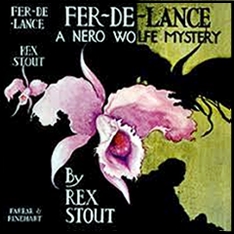
Interestingly, however, Fer-de-Lance and the second novel, The League of Frightened Men (1935), were quickly filmed by Columbia with Lionel Stander (miscast, in Stout’s and my opinion) as Archie. Impeccably filling the title role of Meet Nero Wolfe (1936), the great Edward Arnold was replaced by Walter Connolly — originally envisioned in the part by the studio, although Stout would have preferred Charles Laughton — when Arnold declined to re-up for The League of Frightened Men (1937). David Vineyard admirably analyzed the strengths and, more pointedly, weaknesses of the onscreen League here in a 2020 review so I will, with some relief, turn back to Wolfe’s literary and cinematic debut.
I say this with no authority whatsoever, but suspect that few series have had conventions as numerous and specific as Wolfe’s, which isn’t necessarily a bad thing — with the rules so firmly established, it’s even more fun when you occasionally break them (more on that and the Conrad series in a future post). Stout wastes no time laying them down when we, well, meet Nero Wolfe; an abridgement appeared, as “Point of Death,†in The American Magazine in November 1934. Fer-de-Lance opens, as usual, on New York’s West 35th Street, in “the old brownstone less than a block from the Hudson River where Wolfe had lived for twenty years and where I had been with him a third of that,†per narrator Archie.
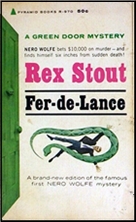
A man of gargantuan girth, appetite, and intellect, Wolfe never (well, hardly ever) leaves the brownstone, wherein also reside those who service his obsessions: food and orchids. Gourmet Swiss cook Fritz Brenner doubles as butler/majordomo; Theodore Horstmann presides over the plant-rooms where Wolfe spends 9:00-11:00 and 4:00-6:00 daily in his unvarying routine, arising at 8:00, breakfasting with the newspapers in his second-floor bedroom, and descending to the office at 11:00. Wolfe sometimes hires outside help in the form of “the three ’teers†— Saul Panzer, Fred Durkin, and Orrie Cather — and Fred sets this plot in motion when, on behalf of wife Fanny, he brings Maria Maffei to Wolfe.
Her brother, immigrant metal-worker Carlo, vanished after receiving a threatening phone call at his rooming-house, where maid Anna Fiore recalls his cutting an article out of the Times about the sudden death of Peter Oliver Barstow. The Holland University president had keeled over while golfing with son Lawrence and friends E.D. and Manuel Kimball at the Green Meadow Club near Pleasantville, his death ruled as coronary thrombosis by eminent Dr. Nathaniel Bradford. In short order, Wolfe dispatches Archie to White Plains with an offer to bet Westchester County D.A. Fletcher M. Anderson $10,000 that, if it is exhumed, Barstow’s body will reveal poison and “a short, sharp, thin needle†in his belly.

He has deduced that Carlo, found stabbed, was hired, and then silenced after a blackmail attempt, to make a club — switched for Barstow’s driver — that would shoot a needle from the handle on impact. When it is found, Ellen Barstow offers $50,000 for her husband’s killer in an ad that her daughter Sarah asks Wolfe to disregard on behalf of the family and Bradford; they were trying to shield Ellen, whose mental instability had led her to take a shot at him months earlier. To Sarah’s relief, circumstantial evidence rules Ellen out, but the absence of any apparent motive remains baffling until Wolfe questions the caddies to learn that on the first tee, with his off looking for a ball, Barstow borrowed E.D.’s driver.
The real target, grain-trader Kimball admits that while living in the Argentine, he’d killed his wife and her lover as his two-year-old son played on the floor, returning 26 years later for Manuel, an aviator and now the obvious suspect. Visiting Wolfe, he rejects the theory about the not-yet-found driver and demands retraction of the warning that E.D.’s life is in danger, but an ad of Wolfe’s own confirms that a plane was seen landing in a pasture near Hawthorne, enabling Carlo’s murder. Q.E.D. when Wolfe, having been lured upstairs on a pretext, and learned that snake venom killed Barstow, finds the titular South American reptile in his desk drawer full of beer-bottle caps, aptly smashing its head with some suds.
Some series take a while to get up to speed, but this isn’t one of them — the characters and dynamics, Archie’s perfect narration and repartee with Wolfe, all spring full-grown from Stout’s brow, and revisiting this after 40+ years, I found myself laughing aloud at regular intervals. Per Wolfe, “it would be futile for a man to labor at establishing a reputation for oddity if he were ready at the slightest provocation to revert to normal action.†He utters his favorite exclamation (“Pfui!â€); only the gathering of interested parties in his office for him to do his ’splainin’, soon a commonplace, is missing as Manuel, confronted with the proof that a faux hold-up has elicited from Anna, kills himself and E.D. in a plane crash…
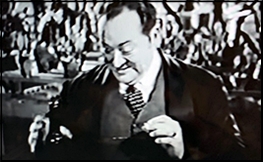
Written by Howard J. Green, Bruce Manning, and Joseph Anthony, Meet Nero Wolfe was directed by Herbert J. Biberman, later one of the blacklisted, HUAC-defying “Hollywood Tenâ€; Maria (now Marie Maringola) was played by Rita Cansino, better known under her subsequent stage name, Hayworth. It opens with the foursome among Emanuel Jeremiah (E.J.) (Walter Kingsford) and Manuel (Russell Hardie) Kimball, Professor Edgar Barstow (Boyd Irwin, Sr.), and Claude Roberts (Victor Jory), engaged to his daughter, Ellen (Joan Perry). We also see Carlo (Juan Torena) apparently poisoned after he cuts out the article, plus the sorry spectacle of would-be wife Mazie Gray (Dennie Moore) harassing Archie.
For some reason, the names of Ellen and Sarah (Nana Bryant) have been switched, while Fritz has been supplanted by Scandinavian chef Olaf, a typical role for John Qualen, part of John Ford’s stock company. Arnold’s joviality as Wolfe — whom Mazie dismisses as a “beer-guzzling orchid-grower†— is the one discordant note as both his physicality and the script stick closely to Stout’s characterization. No sooner has the maid (Martha Tibbetts) identified the article than Wolfe intuits both murders, but when the m.o. he posits results in the exhumation, Det. Lt. O’Grady (Gene Morgan) takes credit, so Wolfe sends Archie to get in writing the offer that Dr. Bradford (Frank Conroy) counsels Sarah to withdraw.
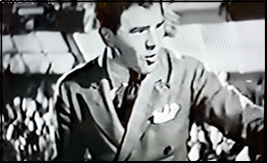
As everyone converges on Wolfe to threaten legal action, Roberts fabricates an excuse to avoid the imminent Manuel, later explaining that he’d been fired as the golf instructor at a Buenos Aires club for allegedly stealing money from E.J.’s locker. The luncheon with caddies Bill (William Anderson), Johnny (William “Billy†Benedict), and Tommy (Roy Borzage) is marred by unwelcome “comic†relief as Mike (George Offerman, Jr.), who’d been fetching E.J.’s visor from the clubhouse, steals frankfurters from Archie’s plate. On learning that his chauffeur was killed by the bite of a fer-de-lance — whose venom did in the others, as well — in his car, E.J. decides that Wolfe’s theory is not “twaddle†after all.
E.J. requests Wolfe’s protection, and Roberts, persuaded to relate his sordid history, adds that Ellen was born in South America and came to the U.S. as a baby, signalling a drastic detour from Stout’s story. E.J. was acquitted of his wife’s murder, believed to have been committed by Sarah’s first husband, Henderson, who vanished that day; she believes that an entity named Hamansa controls her life, and that E.J. killed Henderson. This provides Wolfe with a half-dozen people who had possible motives to kill E.J., so Archie winds up playing Monopoly with the Kimballs while guarding him, and after they narrowly avoid a burst of machine-gun fire, Wolfe orders him to round up, and bring in, the usual suspects.
E.J., Manuel, Ellen, Sarah, Roberts, and Bradford are assembled as reluctant houseguests, ostensibly for protection, though we later learn that it was Marie, firing blanks at Wolfe’s behest. Wolfe receives a package containing a “bomb†that will actually release poisoned gas if submerged in water as a precaution, and after neutralizing it he uses it to smoke out Manuel, who accidentally killed their chauffeur as well as Barstow while trying to avenge his mother. If you’ll forgive a mixed metaphor, Hamansa is a red herring out of left field, and at the close, Archie unthinkably marries the insufferable Mazie — but Wolfe turns out to have an ulterior motive for his wedding gift, a cruise to Paris on the S.S. Île de France.
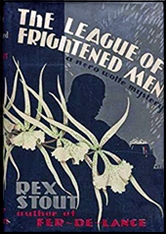
Mind you, this is the man who, in The League of Frightened Gentlemen, relates, “I’m funny about women. I’ve seen dozens of them I wouldn’t mind marrying, but I’ve never been pulled so hard I lost my balanceâ€; mercifully, there is neither sign nor mention of Mazie (or of Olaf) in the screen version, directed by Alfred E. Green. Guy Endore, who scripted with Eugene Solow, is notable — at least in my circles — as the author of The Werewolf of Paris (1933), filmed as Hammer’s The Curse of the Werewolf (1961), and as a scenarist on Mark of the Vampire, Mad Love (both 1935), and The Devil Doll (1936). The novel was serialized in six issues of The Saturday Evening Post (from June 15 to July 20 of 1935) as The Frightened Men.
Featuring an actual excursion by Wolfe, it concerns Paul Chapin, who wrote Devil Take the Hindmost as his quasi-confession for murdering one of the “League of Atonement,†who crippled his leg in a hazing accident. Two die in apparent accidents or suicides, the rest terrified by anonymous verses. Onscreen, after psychologist Prof. Andrew Hibbard (Leonard Mudie) vanishes, taxi driver Pitney Scott (Victor Kilian) opts out when banker Ferdinand Bowen (Walter Kingsford), Dr. Loring A. Burton (Kenneth Hunter), architect Augustus Farrell (Charles Irwin), journalist Michael Ayers (Jameson Thomas), attorney Nicholas Cabot (Ien Wulf), and florist Alexander Drummond (Jonathan Hale) hire Wolfe.
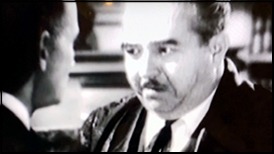
The novel introduces Wolfe’s frequent but mutually respectful sparring partner, Inspector Cramer (whose assistant, Sgt. Purley Stebbins, was invoked but unseen in Fer-de-Lance); Wolfe’s friend and neighbor, Dr. Vollmer; and his sometime freelance hirees Del Bascom and Johnny Keems. As David relates, League is more faithful than Meet Nero Wolfe, yet despite old reliable Eduardo Ciannelli as Chapin, Connolly’s not-at-all-housebound, beer-eschewing Wolfe compounded Stander’s presence. Nana Bryant and Kingsford returned in new roles, the former as Agnes Burton, anticipating the Chaykin series, which — unlike Conrad’s — used only Stout material with a repertory cast as killers, suspects, and victims.
Only after more than 40 years and Stout’s death would Wolfe reappear on U.S. screens…
— Copyright © 2023 by Matthew R. Bradley.
Editions cited:
Fer-de-Lance: Pyramid (1964)
The League of Frightened Men: Pyramid (1963)
Online sources:
February 14th, 2023 at 6:52 am
I had a hard time with both these movies, filing them under “Not My Nero Wolfe.”
February 14th, 2023 at 9:34 am
Although he may have been a perfectly fine fellow, Lionel Stander is the primary culprit for me. I can live with either of the two Wolfe’s, but Stander is not my idea of Archie at all. What were they thinking?
February 14th, 2023 at 11:53 am
I could never abide Stander on general principle, and when the dreaded moment came that I finally saw him as Archie, he unfortunately lived down to all my expectations.
February 14th, 2023 at 3:03 pm
Jerry, thanks so much for the feedback. Obviously, your mileage may vary, but when I first learned years ago that Arnold played Wolfe here, I thought it was perfect casting, and after finally seeing it, only his joviality seemed wrong. Connolly himself bothered me less than the character’s handling by the screenwriters. I was even ready to give him a pass for drinking hot chocolate, which he actually does in the book (although he drinks a LOT more beer), but his distinctly un-Wolfe-ian behavior otherwise, combined with Stander, was a one-two punch that made me a little glad the series was dropped. Of course, in fairness, at that early stage, Stout’s conventions were not yet as firmly established, but I gather he was so disappointed himself that he put the kibosh on further adaptations.
February 14th, 2023 at 3:22 pm
To me, the brilliance of the series lies in the Goodwin/Wolfe interface as an interface between the hardboiled and golden age detective genres. The sedentary wolfe’s unwillingness to leave the house provides a perfect excuse for a hardboiled out of doors investigation by goodwin, who can round up all the suspects into the cozy confines of Wolfe’s abode for a golden age resolution.
February 14th, 2023 at 3:57 pm
Couldn’t have summed it up any better myself! Watch this space for (many) more Wolfe posts…
February 14th, 2023 at 5:12 pm
Archie on radio Gerald Mohr, in my imagination, Cary Grant.
February 14th, 2023 at 7:40 pm
The weird thing about Wolfe, to me, is that his described weight of one-seventh of a ton (270 pounds) is less than my weight and I don’t consider myself grotesquely over-weight.
Might also mention that a decade before creating Nero Wolfe, Rex Stout sold a few novels and several short stories to the pulps. So it’s not like he came out of nowhere when Fer-de-lance appeared.
February 14th, 2023 at 9:04 pm
I groove to almost any story set in the lush nightlife of 1940s New York. I miss that Algonquin Round-Table era; the heyday of Jerome Kern, the Gershwins, Rodgers & Hart … all that posh high life which is now so thoroughly dead and trampled on.
And I also respect Stout’s velvety writing and invention. But somehow deep zest for the Wolfe series never caught fire with me.
That being said, I have often listened to –and frequently enjoyed –several versions of Wolfe on radio. Sidney Greenstreet turns a fine hand, as the corpulent connoisseur of crime.
As Archie: Gerald Mohr and Harry Bartell both do a swell job. I’d give just a faint nod to Bartell as better casting. Slightly more boyish-voiced, which I think fits better.
Rex Stout himself, I’ve learned –was rotund of girth and sported a remarkably full goatee and moustache. This matches how I mentally picture his sleuth: someone like Monty Woolley in “The Man Who Came to Dinner”.
Stout makes several guest-spots on the most beloved unscripted program of the ’40s –the popular “Information Please” quiz show. He comports himself well. Erudite and sagacious; also witty.
He’s growing on me. Wolfe’s snobbishness is sometimes overwhelming but Stout himself seems like a very “regular joe”. I dig that.
February 15th, 2023 at 10:01 am
beb: Been dwelling on that myself…since I’m in the same boat (although down to 281 from a high of more than 300). Maybe I’m a lot taller!
Lazy: Never heard any OTR Wolfe (Karl Schadow, are you there?), but Greenstreet seems ideal. And a great point about Woolley, especially as the acerbic Sheridan Whiteside, who seems equally perfect. Of course, one of the fun things about the series is that since it went on for so long, books can be adapted with period settings that still give you a range of 40 years! Speaking of which, my own “deep zest” (great phrase) will be manifesting itself in a series of upcoming posts about the Wolfe adaptations on U.S. television with William Conrad, Maury Chaykin…and, yes, the inimitable Elliot Stokes and Count Saknussemm himself, Thayer David. Hope they’ll help him grow on you.
February 15th, 2023 at 10:07 am
Matthew
Let’s see if this link works for you:
https://www.otrr.org/OTRRLibrary/index.html?idp=6765
February 15th, 2023 at 10:25 am
I fear the link would lack the power to grant me the time to give them a listen, but thanks!
February 15th, 2023 at 11:19 am
Nice link, Steve. Thanks! I love that stuff!
February 15th, 2023 at 6:37 pm
I’ll do the honors of rounding off the thirteenth comment, a long tradition here.
I agree with most of the comments here, in fact all of them to a great extent.
One point not mentioned is that the movie MEET NERO WOLFE had to tiptoe around and element about two of the suspects that Stout, for the time, was fairly blatant about, namely their sexual preference. It does play a role in the mystery that here is pretty much ignored for obvious reasons to the detriment of the plot.
While I’m a great admirer of Arnold and like Connally in many fine movies, neither man is quite my idea of Wolfe. Arnold is physically closer, and I suppose had he played the part the way he does the millionaire villain in MEET JOHN DOE he might have made a good Wolfe, his screen persona was usually charming and smiling even when he was up to no good though, and I can’t really imagine him being able to repress his usual flamboyance.
But in all honesty, once they cast Stander as Archie there was no saving either film. You cannot overcome a mistake like that. I suppose it could have been worse, we might have gotten Guinn Big Boy Williams or Gordon Jones as Archie, but even they couldn’t have been much worse than Stander (a decent comic character actor, but no leading man).
Of the actors of the time best suited to the role of Wolfe I would have liked to see them go with Francis Sullivan, the British actor and frequent villain who played Dennis Wheatley’s Duc de Richelieu in FORBIDDEN TERRITORY and one of the Four Just Men in THE SECRET FOUR.
Recognizing this was a B film and that limits the stars available I would have preferred Dennis O’Keefe, Lloyd Nolan, or Kane Richmond as Archie though at the time my ideal Wolfe/Archie team might have been Sullivan and Franchot Tone with Barton MacLane as Cramer. I can see sparks firing on screen with that teaming.
February 16th, 2023 at 8:04 am
Lloyd Nolan–good choice. And MacLane would have been a perfect Cramer. Never seen Forbidden Territory, and am by no means a Wheatley expert, but loved Christopher Lee’s Duc in The Devil Rides Out, adapted by the great Richard Matheson. Honored to follow in the footsteps of your nice League piece.
February 18th, 2023 at 12:16 am
Something curious to me about all of Wolfe’s esoteric obsessions (beer, orchids, cuisine) is the way he indulges in them. We see that he goes to great lengths to keep himself constantly surrounded by his passions. He is conscientious that Fritz should have a new and enticing meal ready for him at all times; mindful that a good beer is always available. And I remember Archie remarking that at times, Wolfe will drain his finances for the sake of an orchid find. So: he occasionally succumbs to recklessness. He will act on impulse for the sake of a rare treat and make a ‘rash’ purchase. This is the kind of humanizing quality I seek in a character. Still, the way I always recall him “enjoying himself” is rather in the way Sherlock Holmes “enjoys” the violin. Coldly; with discipline and rigor. Never really ‘losing his head’. Has there ever been a moment in the Wolfe series such as what Conan Doyle provided us with (in the form of) Irene Adler? Has Archie ever strolled into the Orchid Room and found Wolfe ‘just totally gone’, or ‘gaga’, lost in some rapture over one of his prizes? Has a Peking duck or a rare vintage ever made him swoon? Just wondering.
February 18th, 2023 at 10:23 pm
Lazy, there are references in the books, especially in BLACK MOUNTAIN, that Wolfe as a young man let his passions dictate to him and it led him into trouble. Marco, his half brother seems to know something of that passionate past, and the daughter that shows up at Wolfe’s door seems to testify to that.
Wolfe seems embarrassed by his past and letting his passions get the best of him and angry when anything seems to bring that past out.
I’ve always suspected that Stout meant us to believe Wolfe may have killed a man as a result of those passions and reacted to that by suppressing them from then on whether the killing was justified or not. That’s just my take on the character, but I think a careful reading of the saga would give that speculation some weight.
February 19th, 2023 at 12:28 am
Cool. I’d be keen to hear more such speculation.
February 26th, 2023 at 5:54 am
“ where maid Anna Fiore recalls his cutting an article out of the Times about the sudden death of Peter Oliver Barstow.â€
Is this from the movie? In the book, Wolfe has to cut out a variety of articles and show Anna the patterns of the front page. She remembers there was an article cut out, but not what the article was.
@17:Where does this idea of Marco being his half brother come from?
February 27th, 2023 at 4:18 pm
Terry, that’s from the book, but it was, for lack of a better word, shorthand. She recalls his cutting an article out of the Times, and we later learn by process of elimination what the subject of the article was, but I was trying to express that as concisely as possible. You are, of course, quite right about the sequence of events.
September 14th, 2023 at 9:34 pm
A Bit Belatedly:
Check any extant photographs of Rex Stout from any period of his life.
Rex Stout was never “rotund of girth” at any time in his 80+ years of life; quite the opposite.
Let one quote from the late ’60s serve for many:
W.S. Baring-Gould in Nero Wolfe Of West Thirty-Fifth Street:
“Stout has for many years been a lean 150 pounds and has the energy of a draft horse.”
This can be verified in almost any other biographical profile of Rex Stout, both before and after the Baring-Gould book.